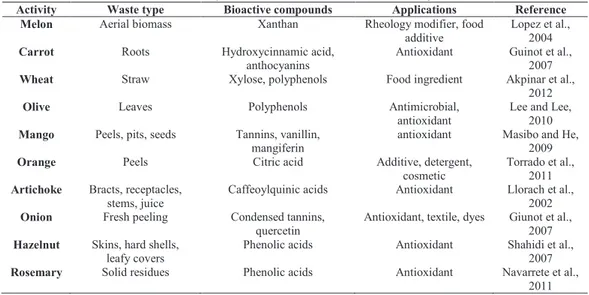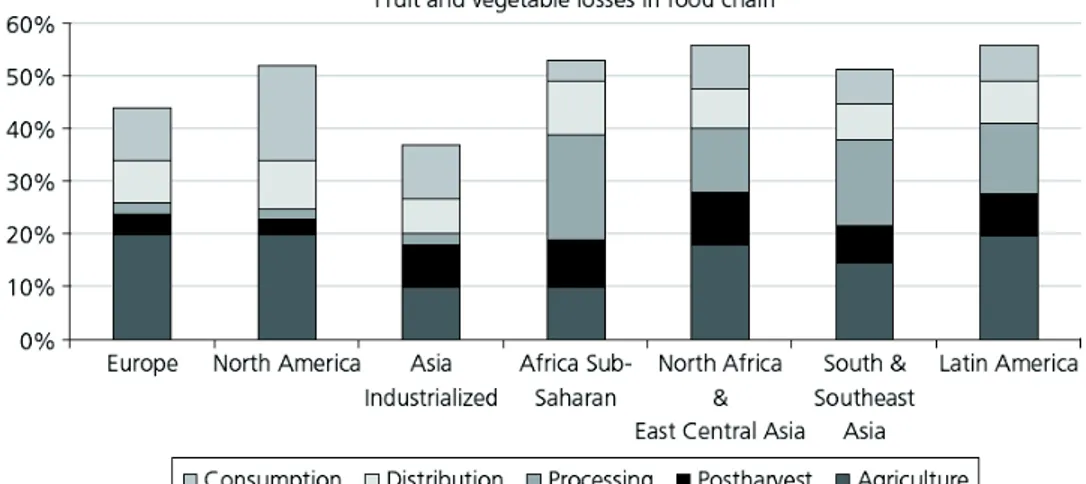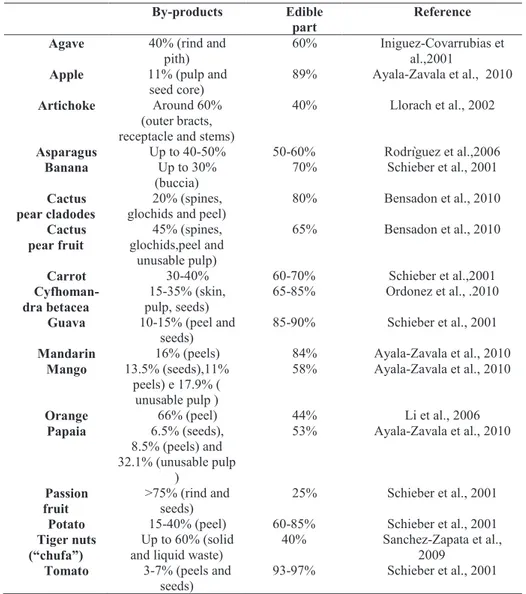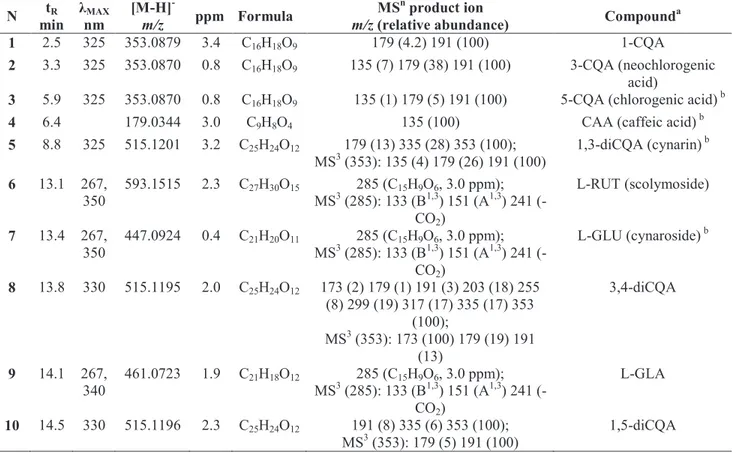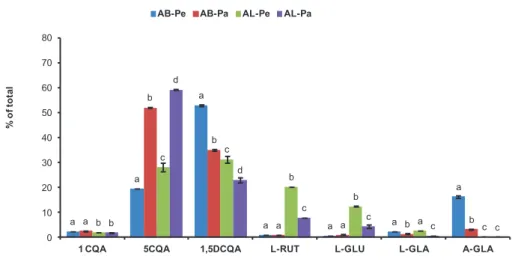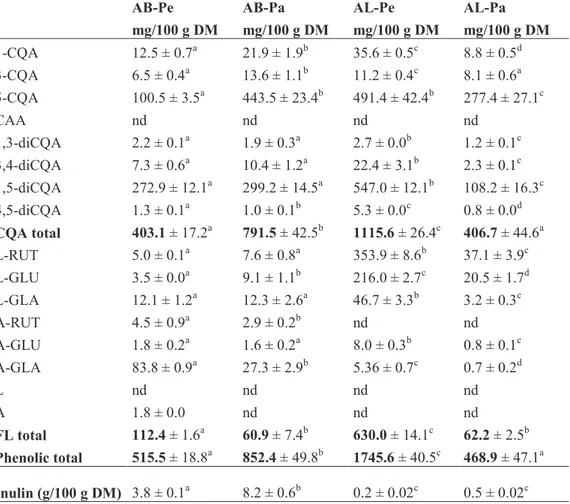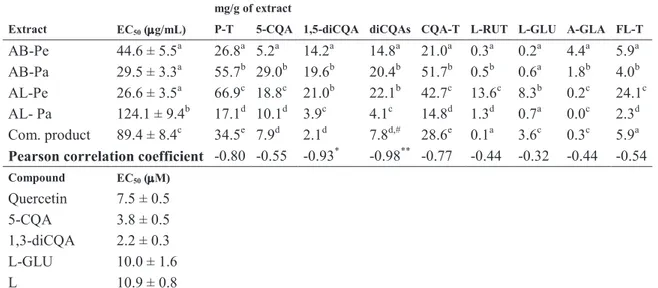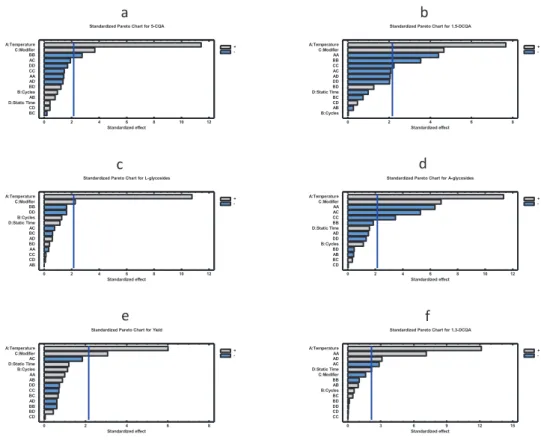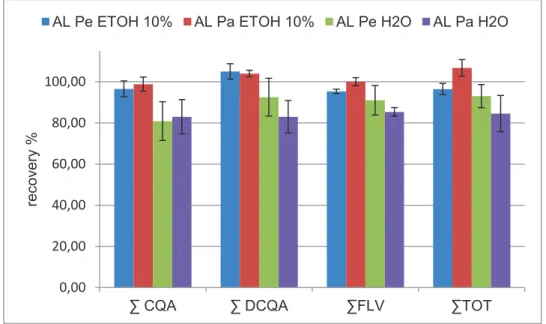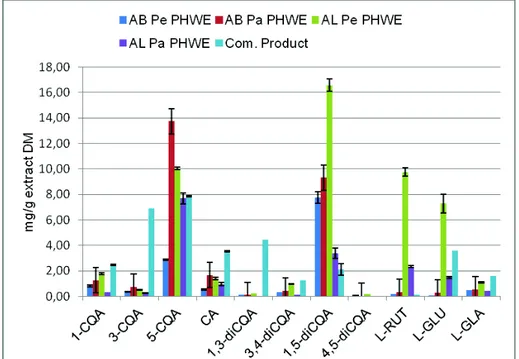II
Table of Contents TABLE OF CONTENTS ABSTRACT I INTRODUCTION Introduction 3 Aim 4 Selected matrices 5 General conclusions 6 CHAPTER I
AGRICULTURAL RESIDUES AS A SOURCE OF BIOACTIVE NATURAL PRODUCTS
1.1. Introduction 9
1.2. Agricultural residues 10
1.3. Valorisation processes 10
1.4. Recovery of bioactive natural products 12
1.5. Bioactive compounds from vegetable and fruit by-products 13 1.6. Remarks on the use of by-products and future prospects 16 1.7. Food waste valorisation: winery waste and by-products 18
CHAPTER II
TECHNIQUES FOR ANALYSIS OF BIOACTIVE COMPOUNDS 2.1. Extraction 23 2.1.1. PLE 25 2.1.2. SFE 27 2.1.3. UAE 28 2.2. Analytical techniques 28 EXPERIMENTAL PART
II CHAPTER III
SECTION A
CHEMICAL PROFILE AND CELLULAR ANTIOXIDANT ACTIVITY OF ARTICHOKE BY-PRODUCTS
3A 1. Introduction 35
3A 2. Results and discussion 36
3A 2.1. Phenolic profile of artichoke by-products by UHPLC-DAD-HRMSn
36
3A 2.2. Quantitative profile of artichoke by-products 41
3A 2.3. Inulin content of artichoke by-products 46
3A 2.4. Cellular antioxidant activity (CAA) of artichoke by-products
46
3A 3. Conclusions 50
3A 4. Materials and methods 50
3A 4.1. Materials 50
3A 4.2. Artichoke by-product samples 51
3A 4.3. Phenolic compounds extraction 52
3A 4.4. UHPLC-DAD-HRMSn analysis 52
3A 4.5. Quantitative analysis by UHPLC-UV 53
3A 4.6. Determination of inulin 55
3A 4.7. Cell cultures, treatments and viability assay 56
3A 4.8. Cellular antioxidant activity (CAA) assay 56
3A 4.9. Statistical analysis 57
CHAPTER III SECTION B
RECOVERY OF BIOACTIVE COMPOUNDS FROM ARTICHOKE BY-PRODUCTS BY PRESSURIZED HOT WATER EXTRACTION (PHWE)
Table of Contents
3B 2. Results and discussion 64
3B 2.1. Preliminary experiments 64
3B 2.2. Optimization design 66
3B 2.3. PHWE validation 71
3B 2.4. Application of PHWE technique and comparison with commercial product
74
3B 2.5. Cellular antioxidant activity (CAA) of PHWE extracts 75
3B 3. Conclusions 77
3B 4. Materials and methods 78
3B 4.1. Solvents and reagents 78
3B 4.2. Plant material 78
3B 4.3. Pressurized hot water extraction (PHWE) 79
3B 4.4. HPLC analysis 80
3B 4.5. Experimental of design (DoE) 80
3B 4.6. Cell cultures, treatments and viability assay 81
3B 4.7. Cellular antioxidant activity (CAA) assay 81
CHAPTER IV SECTION A
CHEMICAL PROFILE OF ROASTED HAZELNUT SKINS BY-PRODUCT
4A 1. Introduction 85
4A 2. Results and discussion 89
4A 2.1. RHS extraction 89
4A 2.2. PAs quantification 89
4A 2.3. RHS chemical profiling by mass spectrometry 90
4A 2.4. Thiolysis 91
4A 2.5. HRMS-FIA 92
4A 2.6. HPLC-HRMSn analysis 96
IV
4A 4. Materials and methods 104
4A 4.1. Materials 104
4A 4.2. Hazelnut skin samples 104
4A 4.3. Extraction procedure 105
4A 4.4. HRMS-FIA 105
4A 4.5. HPLC-HRMS analysis 106
4A 4.6. Thiolysis 106
4A 4.7. Determination of condensed tannins, vanillin assay 107
CHAPTER IV SECTION B
PRESSURIZED HOT WATER EXTRACTION OF
PROANTHOCYANIDINS FROM ROASTED HAZELNUT SKINS BY-PRODUCT
4B 1. Introduction 111
4B 2. Results and discussion 112
4B 2.1. Preliminary experiments 112
4B 2.2. Optimization design 116
4B 2.3. PHWE validation and comparison with exhaustive extraction
123
4B 3. Conclusions 125
4B 4. Materials and methods 125
4B 4.1. Materials 125
4B 4.2. Hazelnut skin samples 126
4B 4.3. Pressurized hot water extraction (PHWE) 126
4B 4.4. HPLC-HRMS analysis 127
4B 4.5. Thiolysis 128
4B 4.6. Vanillin assay 128
Table of Contents
CHAPTER V SECTION A
CHEMICAL PROFILE AND ANTIOXIDANT ACTIVITY OF ESSENTIAL OIL DISTILLATION WASTEWATERS FROM AROMATIC HERBS
5A 1. Introduction 133
5A 2. Results and discussion 135
5A 2.1. Qualitative analysis 135
5A 2.2. Profiling DWWs 150
5A 2.3. Quantitative analysis by UHPLC-UV 152
5A 2.4. Antioxidant activities measurement 157
5A 3. Conclusions 160
5A 4. Materials and methods 161
5A 4.1. Materials 161 5A 4.2. DWW samples 162 5A 4.3. HPLC-DAD-HRMS analysis 163 5A 4.4. Determination of RA by HPLC-UV 164 5A 4.5. Folin-Ciocalteau assay 165 5A 4.6. DPPH assay 165 5A 4.7. ABTS assay 166 5A 4.8. ORAC assay 167
5A 4.9. Trolox Equivalent Antioxidant Capacity (TEAC) 167
CHAPTER V SECTION B
SELECTIVE EXTRACTION OF BIOACTIVE COMPOUNDS OF DISTILLATION WASTEWATER FROM OCIMUM BASILICUM L. BY SUPERCRITICAL ANTISOLVENT FRACTIONATION
VI
5B 2. Results and discussion 173
5B 2.1. Hansen solubility parameters estimation 173
5B 2.2. PLE extraction 174
5B 2.3. SAF experiments 178
5B 3. Conclusions 181
5B 4. Materials and methods 182
5B 4.1. Samples and reagents 182
5B 4.2. Steam distillation 182
5B 4.3. Pressurized liquid extraction 182
5B 4.4. Quantitative analysis by HPLC-UV 183
5B 4.5. Supercritical antisolvent fractionation 184
References 187
Abstract
I
ABSTRACT
Agriculture and agri-food industry produce a large amount of residues in non-edible portions from cultivation and processing of crops. These wastes, considered by-products, give serious environment damage, if not properly disposed, also because of their seasonal production. Until a few years ago the only goal was the disposal of these by-products. Recently the researchers discovered the characteristics of these wastes and their possible exploitation as sources of interesting compounds and energy for pharmaceutical, cosmetics and nutraceutical sectors. Fruit and vegetable by-products, in fact, are rich in bioactive compounds, such as carotenoids, dietary fibers, minerals and phenolic compounds, with correlated beneficial health effects.
In this context the activity of the PhD project evaluated agricultural by-products as sources of bioactive compounds.
The aims of the present PhD project were the development of innovative and
selective analytical methodologies, for determination of bioactive
compounds, using liquid chromatography methods (UHPLC) coupled to UV-Vis spectroscopy and mass spectrometry (high resolution, HRMS and tandem mass, MS/MS), the improvement of new extraction techniques, which can optimize extraction yields, minimize costs and environmental impact, such as pressurized hot water extraction (PHWE), ultrasound assisted extraction (UAE) and supercritical antisolvent fractionation (SAF), and finally the study
of antioxidant activity of obtained extracts, using chemical and biological
assays (DPPH, ABTS, ORAC, CAA).
The analysis of bioactive compounds in plant extracts through advanced sample preparation techniques and modern separation tools allows a comprehensive study of the matrix. The project, very relevant, was to provide innovative methodologies, procedures and final products for different companies of healthcare area, in terms of innovation, costs and profits.
II
The project was divided into three major areas, corresponding to the three selected by-products. The determination of chemical profile and the development and optimization of innovative and green extraction procedure for recovery of bioactive compounds have been carried out for each matrix. Selected by-products were: the main artichoke by-products, bracts and leaves, derived from cultivation and industrial processing, hazelnut
by-products, roasted skins, derived from kernel industrial processing, and aromatic plants by-products, distillation waste waters, derived from
essential oils production.
All by-products studied have proved to be low cost sources of bioactive compounds with antioxidant activity. Furthermore, among innovative extraction techniques, PHWE procedures have allowed obtaining final extracts selectively rich in compounds of interest without formation of artefacts, and compared to existing extraction methods were simple, fast, environmentally friendly and fully automated. Moreover my PhD project provided new analytical methods to standardize vegetable extracts. The most relevant results showed that discarded raw materials are suitable ingredients for the production of formulated health products and nutraceuticals.
Introduction
1
Introduction
3
The following section is a summary of the PhD thesis. It includes: 1) a brief introduction about agricultural by-products,
2) aim,
3) selected matrices, 4) general conclusions.
1) Introduction
Nowadays there is a modern vision of agriculture as an activity that can not only satisfy nutritional needs, but also supports other sectors such as nutraceutical, cosmetic and pharmaceutical. This perspective is based on the large amount of nutrients resulting from the primary metabolism of plants, as well as the variable presence of secondary metabolites. Secondary metabolites are bioactive compounds that through certain mechanisms are able to provide benefits to human organism, for therapeutic purposes. However pharmaceutical industry rarely makes use of the whole plant, but through special extraction techniques extracts required components, which are used as isolated ingredients in drugs. In addition, food industry selects only the edible portion of plant, promoting the formation of a large amount of wastes and organic by-products. Agriculture follows the market needs and produces only what can be sold. In fact, residues left in the fields and derived from industrial processing must be necessarily disposed. By-products are currently used as potential raw materials for re-use. In this perspective "waste" of a process becomes "resource" for another.
A large amount of by-products are generated by food industry at every stage of the production processes. Generally, agricultural by-products are valorised as animal feedstuff, in fuel and fiber production. In the last years, some vegetables by-products have been valorised as a source of bioactive
4
phytochemicals and several studies have focused on the recovery of bioactives from agricultural and food waste and their application in food, functional foods, dietary supplements and cosmetics.
2) Aim
The activity of the PhD project focused on the exploitation of agricultural by-products as sources of naturally bioactive compounds with health promoting, disease preventing, or medicinal properties. The major aims are the development and the evaluation of the applicability of agricultural waste derived products as components of foods, functional foods, dietary supplements and herbal products. The general aims of the present work were: a) To develop innovative and selective analytical methodologies for the
quali-quantitative characterization of bioactive compounds from selected by-products using liquid chromatography methods (UHPLC) coupled to UV-Vis spectroscopy and mass spectrometry (high resolution, HRMS and tandem mass, MS/MS). The identification of bioactive compounds is preliminary action to be carried out before extraction and purification processes, to be able to understand the nature and the complexity of the matrix and its constituents. The knowledge of the quantitative profile is however necessary to check the real added value of by-products and to understand their potential applicability. Moreover, chemical, enzymatic and spectrophotometric methods were applied in order to obtain a complete and comprehensive characterization of by-products.
b) To develop new extraction procedures in order to optimize extraction yields, to minimize costs and environmental impact and to obtain enriched extracts that add value to by-products. This goal was achieved using non-conventional extraction techniques as pressurized hot water extraction
Introduction
5
(PHWE), ultrasound assisted extraction (UAE) and supercritical antisolvent fractionation (SAF). The recovery of bioactive compounds was designed with the aim to enrich the fraction of interest and to eliminate or to reduce inert component (lipids, polysaccharides, pigments, proteins) that could make problematic the subsequent handling of the obtained derivative products and reduce the enrichment factor.
c) Assessment of the potential usefulness of the products obtained, after appropriate modifications (enriched extracts, partially purified fractions and isolated components) to supply methodologies and procedures for industrial applications.
d) Finally to study the antioxidant activity of obtained extracts, using chemical and biological assays (DPPH, ABTS, ORAC, CAA).
3) Selected matrices
The following matrices, supplied by local companies, have been selected and studied: the main artichoke by-products, bracts and leaves, derived from cultivation and industrial processing, hazelnut by-products, roasted skins, derived from kernel industrial processing, and aromatic plants by-products, distillation waste waters, derived from essential oils production, taking into account the percentage of waste, the needs and problems of the territory and the richness in bioactive compounds level after a literature search. Results, discussion, materials and methods are reported in experimental part, divided in three main chapters: chapter III, artichoke by-products divided in Section A and Section B, chapter IV, hazelnut by-products divided in Section A and Section B, chapter V, aromatic plant by-products divided in Section A and Section B.
6 4) General conclusions
All by-products studied have proved to be low cost sources of bioactive compounds, mainly belonging to polyphenols natural products class. Among the sample preparation techniques, PHWE employed has allowed obtaining final extracts selectively rich in compounds of interest in a faster and economically friendly manner, without formation of artefacts, respecting the originality of vegetable matrix, while using SAF enriched and purified fractions were obtained. The antioxidant activity of exhaustive extracts and PHWE extracts were evaluated to assess future applications by chemical and biological assays (DPPH, ABTS, ORAC and CAA). In conclusion the project results provided three new characterized, optimized and standardized extracts. The above raw materials are suitable ingredients for the production of formulated health products and nutraceuticals.
Chapter I
7
CHAPTER Ⅰ
AGRICULTURAL RESIDUES AS A SOURCE OF
BIOACTIVE NATURAL PRODUCTS
Chapter I
9 1.1. Introduction
Agriculture and agri-food industry produce a large amount of residues in non-edible portions from cultivation and processing of crops and by-products; these wastes give serious environment damage, if not properly disposed, also because of their seasonal production. There are a lot of methods to correctly dispose or exploit different type of residues. Until a few years ago the only goal was the disposal of these by-products, but now the researchers found the characteristics of these wastes and their possible exploitation as sources of interesting compounds and energy for pharmaceutical, cosmetics and food industries (Peralbo-Molina and Luque de Castro, 2013). Food waste is generated in big quantities worldwide. It is estimated that are produced billions of metric tons of biomass each year in liquid, solid and gaseous form and they constitute perhaps the most renewable and cheap source in the world. This context has attracted the interest of researchers in order to develop sustainable processes. Agricultural by-products can be used as raw materials, directly or converting them using physical, chemical and biochemical processes or fractionating them in order to produce energy, fuels, materials and high-value products, to exert in most cases their biological activities (antioxidant and pharmacological properties). According to Waste Framework Directive (European Union 2006): waste is a material which the holder discards or indented or is required to discard; production residue is a material that is not deliberately produced in a production process that may or not may a waste; by-product is a production residue that can be used directly without any further process other than normal industrial practice, whereas unprocessed and unadulterated material, which has been separated from the crop could be considered a co-products.
Food industry processing is associated with transformation of raw material into a food product. Now there is the intention to develop processes with food
10
production, minimization of water and energy consumption and valorisation of by-product segments.
1.2. Agricultural residues
There are two important groups of agricultural residues: crop residues, derived from farm practices and agro-industrial residues (post-harvest process). Non-edible plant parts are left in the field after harvest of main crop, as branches, roots, haulms, leaves, stalks, stubble, straw, twigs and sticks (primary biomass). Agro-industrial residues derived from food processing industries, take the form of hulls, husks, peels, pomace (secondary biomass) (Mande, 2005). There is not statistical information about quantities of residues; it’s only possible to estimate their amount from the product yield and residue to crop ratios (Chen et al., 2009).
1.3. Valorisation processes
Agricultural residues represent a huge amount of biomass inducing strong impact on environment and greenhouse effect (Galanakis, 2012). Combustion is usually the only practice in the farms but removing all crop residues could provoke soil deterioration and declining yields. So a little amount of these residues must return in farm in order to preserve soil quality avoiding erodible lands (Lal, 2005). Nowadays, physical, chemical, biological and enzymatic pre-treatments are performed. In fact, large quantities of residues, in particular lignocellulosic materials, are used for bio-energy production. At the same time, agricultural wastes are employed for animal feed production, compost and wood-based panels, bio-fertilizers, bio-fibers. Furthermore, bioactive natural products can be obtained by biological and chemical processes. Flow diagrams (Figure 1) reports agricultural biomass conversions.
Chapter I
11
Figure 1 Flow diagram of agricultural biomass conversions
(Santana-Méridas et al., 2012).
Agricultural and food processing segments produced wastes in a more concentrated way and with some related problems: serious pollution problem for high value of COD (Chemical Oxygen Demand) and BOD (Biological Oxygen Demand) due to mostly organic nature; varying pH conditions and chemical composition because of seasonal character; easily bacterial contamination (vegetable and fruit by-products); high water content; high accumulation (disposal problem). Current practices for food waste disposal are: animal feed, composting, incineration and landfill (Lin et al., 2013). High COD, high BOD and also high concentrations of substances with antimicrobial and antioxidant properties preclude disposal via the ordinary wastewater treatment (mainly sewage system) and irrigation and/or fertilization of cultivated fields (Ledesma-Escobar and de Castro, 2015). Pressing extraction, the oldest method to obtain olive oil, produces a liquid waste, known as OMWW (olive mill wastewaters), which is residual water after oil decantation. This waste has very high COD (up to 200 g/L) and BOD (up to 100 g/L) values, with several environmental problems. Its organic fraction
12
consists of pectins, lipids, sugars and aromatic compounds, which are responsible for antimicrobial activity and phytotoxicity (Ledesma-Escobar and de Castro, 2015).
1.4. Recovery of bioactive natural products
Methodologies for the use of by-products can be grouped into three categories: 1. recovery of natural compounds using conventional and
non-conventional extraction techniques;
2. utilization and optimization of lead compounds in order to develop analogues by synthetic strategies;
3. bioprocess development to produce bioactive compounds.
Table 1 summarizes the potential value of crop-based and processing-based agricultural residues as raw materials for some applications.
Table 1 High added-value product from crop-based and processing-based
residues (Santana-Meridas et al., 2012).
Activity Waste type Bioactive compounds Applications Reference Melon Aerial biomass Xanthan Rheology modifier, food
additive
Lopez et al., 2004 Carrot Roots Hydroxycinnamic acid,
anthocyanins
Antioxidant Guinot et al., 2007 Wheat Straw Xylose, polyphenols Food ingredient Akpinar et al.,
2012 Olive Leaves Polyphenols Antimicrobial,
antioxidant
Lee and Lee, 2010 Mango Peels, pits, seeds Tannins, vanillin,
mangiferin
antioxidant Masibo and He, 2009 Orange Peels Citric acid Additive, detergent,
cosmetic
Torrado et al., 2011 Artichoke Bracts, receptacles,
stems, juice
Caffeoylquinic acids Antioxidant Llorach et al., 2002 Onion Fresh peeling Condensed tannins,
quercetin
Antioxidant, textile, dyes Giunot et al., 2007 Hazelnut Skins, hard shells,
leafy covers
Phenolic acids Antioxidant Shahidi et al., 2007 Rosemary Solid residues Phenolic acids Antioxidant Navarrete et al.,
2011
Bioactive compounds are recovered using conventional and non-conventional extraction techniques. Conventional methods are solid-liquid and liquid-liquid
Chapter I
13
extractions that changing parameters such as type of solvent, time and temperature of extraction can influence recovery of valuable compounds. Recently, new extraction non-conventional techniques are developed in order to recover more efficiently bioactive compounds: supercritical carbon dioxide extraction, ultrasound assisted extraction, pressurized liquid extraction and others (Wijngaard et al., 2012). Moreover, in literature for example are reported enzymatic modifications of hydroxytirosol and chemo-enzymatic modifications of resveratrol respectively from olive and grape by-products in order to produce semi-synthetic analogues perhaps with incremented pharmacological activity (Spatafora and Tringali, 2012). Solid state fermentation (SSF) is employed like a bioprocess for growth of microorganism capable of producing bioactive compounds (Martins et al., 2011).
1.5. Bioactive compounds from vegetable and fruit by-products
Nowadays the eating habits of the population have changed and as a result there is a greater awareness of the effects of nutrition on health and quality of life. Consumers demand fresh or minimally processed products that can provide nutrients and at the same time positive biological effects and of course safe products from a microbiological point of view. Phytochemicals, in fruits and vegetables, are responsible for the beneficial effects on human health. Furthermore, consumers demand safer products without synthetic additives because of negative effects that these may exercise. In this scenario, there is demand for food quality, natural ingredients and safe additives with positive biological effect and nutritional values. Recently there is a trend for consumption of products rich in phytochemicals or food enriched in them, in order to assure the health effects, because of greater knowledge of beneficial activities obtained. Fruit and vegetable by-products are rich in phytochemicals,
14
such as carotenoids, dietary fibers, minerals and phenolic compounds. In literature there are many studies, in vitro and in vivo, that correlate a diet rich in fruits and vegetables with a low incidence of degenerative and cardiovascular diseases (De Ancos et al., 2015). It’s possible to define phytochemicals as bioactive compounds due to their biological properties. They can exert beneficial effects with synergistic or additive interactions by acting on target pathway in human organism (Liu, 2013).
Each stage in agricultural and food industry ‒ food production, processing, transportation, storage, distribution and marketing ‒ provokes an impact on pollution with formation of by-products (derived from packaging, canning, freezing, drying, washing, peeling, blanching steps), waste and air emissions. Wastes are different in quality and quantity and there is the need to reduce the impact technologies and processing methods on the environment. In many countries there is the necessity to increase agricultural production due to increasing population but it’s required to focus attention on environmental problems searching a balance between agricultural development and environment protection. There are several side effects of agricultural inputs (fertilizers, pesticides, feed additives) such as contamination of ground and water, ammonia emissions, acid rains, accumulation of heavy metals in soils. Figure 2 represents the percentage of the initial weight of vegetables and fruits that are disposed at each step of food supply chain (FSC). It’s possible to assess that in some countries over than 40% of initial weight is discarded (Europe) and this percentage becomes higher in less industrialized countries (North Africa & East Central Asia and Latin America). In Europe agriculture has the major impact on food waste (about 20%). Waste regarding consumption is also considerable (15-30%); postharvest step waste is high because of perishable and seasonal characters of crops and fruits.
Chapter I
15
Figure 2 Percentage of fruit and vegetable production discarded at different
steps of FSC (De Ancos et al., 2015).
Normally in vegetable processing step, canning and freezing operations produce large amounts of by-products, but also at level of selection and classification there is a big quantity discarded because of fungal attack or mechanical injury, or size and maturity not-compliant. The step of elimination of the non-edible portion involves that a further significant amount is discarded. At this level, for example, artichoke’s waste is about 50-60% of the initial weight (Larrosa et al., 2002). The most important processed fruits produced worldwide are fruit juices and it’s evaluated that 40% of citrus fruit production is involved in fruit juices and consequently are produced as wastes peels, pulps, stones, seeds, pomace. According to Directive 2006/12/EC, integrated in Directive 2008/98/EC, there are some laws and requirements that oblige to practice recycling, recovery and reuse of food waste as source of energy and valuable compounds with nutritional and functional characteristics. In Table 2 is reported approximately the percentage amount of some agricultural by-products generated by processing industry. It is evident that in
16
some cases the percentage discarded is more than 40%, as artichoke, mango, orange, asparagus (Goñi and Hervert-Hernández, 2011).
Table 2 Amount of by-products generated from fruit and vegetable processing
industry (Goñi and Hervert-Hernández, 2011).
1.6. Remarks on the use of by-products and future prospects
Valorisation of fruit and vegetable by-products involves some considerations before their utilization. First of all, starting materials are not homogenous and
By-products Edible part
Reference Agave 40% (rind and
pith)
60% Iniguez-Covarrubias et al.,2001
Apple 11% (pulp and seed core)
89% Ayala-Zavala et al., 2010 Artichoke Around 60%
(outer bracts, receptacle and stems)
40% Llorach et al., 2002
Asparagus Up to 40-50% 50-60% Rodrìguez et al.,2006 Banana Up to 30% (buccia) 70% Schieber et al., 2001 Cactus pear cladodes 20% (spines, glochids and peel)
80% Bensadon et al., 2010 Cactus pear fruit 45% (spines, glochids,peel and unusable pulp) 65% Bensadon et al., 2010
Carrot 30-40% 60-70% Schieber et al.,2001
Cyfhoman-dra betacea
15-35% (skin, pulp, seeds)
65-85% Ordonez et al., .2010 Guava 10-15% (peel and
seeds)
85-90% Schieber et al., 2001 Mandarin 16% (peels) 84% Ayala-Zavala et al., 2010
Mango 13.5% (seeds),11% peels) e 17.9% (
unusable pulp )
58% Ayala-Zavala et al., 2010
Orange 66% (peel) 44% Li et al., 2006
Papaia 6.5% (seeds), 8.5% (peels) and 32.1% (unusable pulp ) 53% Ayala-Zavala et al., 2010 Passion fruit >75% (rind and seeds) 25% Schieber et al., 2001 Potato 15-40% (peel) 60-85% Schieber et al., 2001 Tiger nuts
(“chufa”)
Up to 60% (solid and liquid waste)
40% Sanchez-Zapata et al., 2009
Tomato 3-7% (peels and seeds)
Chapter I
17
may come from different fields, cultivation procedures, conditions and processing and consequently standardization is necessary. Agricultural by-products are characterized by biological instability because of high microbial load ‒ than can affects product safety and naturally to accelerate microbial degradation ‒ and high water load ‒ which entails higher costs for the transport because of the weight increased. For example drying costs and pressing for artichoke (90% water content) and tomato (71% water content) involve very high costs (Peschel et al., 2006). Obviously the water after pressing has a high organic load and must be properly recycled. Furthermore by-products with high fat content may undergo to oxidation of fatty acids and consequently formation of bad smells. A problem very important is the presence of active enzyme inside by-products that can be inactivate for example using blanching or thermal step, in order to avoid degradation of phytochemicals. Some pre-treatments are necessary before to use by-products: wet grinding (to reduce particle size), drying (lyophilisation, oven) (O'Shea et al., 2012). Drying should be done as close to the location production to reduce volume and cost of transport. Several and additionally studies are necessary to ensure safe bioactive compounds extracted from by-products, free of pesticides and toxic molecules (solanin, patulin, ochratoxin, dioxins). Bioavailability studies are very important to determine the effective activity of phytochemicals. So are necessary interdisciplinary studies and coordination among them (De Ancos et al., 2015).
The future prospect related to waste management is the utilization of by-products as raw materials to provide the generation of different by-products with various applications. Moreover by-products reuse together with minimization waste production will allow the development of zero-waste production processes.
18
1.7. Food waste valorisation: winery waste and by-products
The following explains a study focusing on integrated valorisation of food supply chain waste by green chemical conversion routes and biotechnological applications. Worldwide wine production is about 280 million hectolitres. Wine residues are mainly composed of grape stalks, grape pomace, marc, waste waters and waste lees. The novel biorefinery concepts could provide a suitable solution. Grape stalk is lignocellulosic material, with great mineral content, and normally are burned (greenhouse effect and release of toxic compounds). It’s possible to employ grape stalks for C5-C6 sugar production by fermentation processes. Hemicellulose hydrolyzates were fermented by L. Pentosus for lactic acid and biosurfactants production. Furthermore grape stalks are sources of antioxidant compounds, hydroxicinnamic and hydroxibenzoic acids. In this scenario, extraction of antioxidants could be done prior to fermentation processes. Similarly grape marc, generated after pressing, is employed for fermentative lactic acid production. Grape marc is also a source of tannins to produce wood adhesives and is used in solid state fermentation for bioethanol production.
Wine lees is the residue at the bottom of recipients containing wine, after fermentation and the residue obtained following filtration and centrifugation of wine: it represents about 2-6% of total volume of wine and is rich of ethanol, tartaric acid and yeast cells. This by-product for its high phenolic content is not suitable for animal feed production. In literature extraction of phenolic compounds is reported from wine lees by microwave-assisted extraction and supercritical fluids (Lin et al., 2014).
Furthermore grape seeds represent valuable by-products for their lipid profile mainly composed of linoleic acid and vitamin E. Recently these seeds are used as culinary oil. Grape seeds are important sources of proanthocyanidins too, with antioxidant properties: their extracts were employed as antimicrobial
Chapter I
19
additives in soy protein edible films, inhibiting the growth of L. monocytogenes, E. coli and S. tyhimurium. Grape seeds extracts could find applications in cosmetic and nutraceutical sectors as colorants, flavour modifiers and antioxidants (Ledesma-Escobar and Luque de Castro, 2015)
Chapter II
21
CHAPTER Ⅱ
TECHNIQUES FOR ANALYSIS OF BIOACTIVE
COMPOUNDS
Chapter II
23
For chemical determination of bioactive compounds in vegetable extracts is advisable the combination of advanced sample preparation techniques and separation tools. Sample preparation is the most important phase due to necessity of selective and efficient extraction of target compounds. It converts real matrix into a sample suitable for subsequent analytical techniques.
Recently the development and application of modern sample preparation techniques provide various advantages.
2.1. Extraction
The preparation and extraction of bioactive compounds depends on the nature of sample matrix and chemical properties of its compounds. For liquid sample, liquid-liquid extraction (LLE) is employed, while for solid sample, solid-liquid extraction (SLE) is used.
In the case of phenolic compounds, polarity, molecular structure and number of hydroxyl groups are important. Some of these compounds are complexed with proteins, carbohydrates and for sample preparation freeze-drying, air-drying and oven-air-drying are useful.
Afterwards dried matrices are milled in order to obtain fine particle size while liquid samples undergo centrifugation, filtration and purification. For samples with lipids are usually applied defatting processes. These steps are performed prior to extraction, because is necessary to prepare samples for subsequent analysis.
Organic and inorganic solvents are employed to extract bioactive compounds. Some parameters can influence extraction yields, such as temperature, time, solvent to sample ratio, solvent. The most used solvents are ethanol, acetone, ethyl acetate, water and methanol. Higher temperature and extraction time can allow increased analytes solubility, but at high temperatures degradation phenomena can occur. Solvent to sample ratio and number of extraction cycles
24
can enhance recovery. Bioactive compounds can be linked to other inert materials: addition of enzymes and acidic/alkaline hydrolysis can promote release of compounds and their stability, respectively.
Extraction is fundamental for separation and recovery of bioactive compounds, after sample preparation and removal of undesirable compounds. Soxhlet and maceration are conventional extraction techniques and are performed for several hours. Main disadvantages are: large volumes solvents, hazardous organic solvents and long extraction times. Recently there is an increased demand for alternative and non-conventional techniques to overcome all these disadvantages. New techniques allow short extraction times, reduced volume organic and hazardous solvents and are very simple to perform, achieving a decrease in the use of energy and water too (Khoddami et al., 2013).
Before the coming of Green Chemistry, green extract was obtained using lower energy and solvent consumption, but now it is the final result after a long process that is wholly green, starting from production and harvesting of plant to transformation and formulation. Pharmaceutical, cosmetic and food industries have recognized these concepts and reached a point of meeting increasing extraction efficiency, reducing or eliminating hazardous solvents, moderating energy consumption. Chemat gives a definition of green extraction: “Green extraction is based on the discovery and design of extraction processes which will reduce energy consumption, allows use of alternative solvents and renewable natural product, and ensure a safe and high quality extract/product” (Chemat et al., 2012).
The objectives are:
· use of alternative solvents;
· use of renewable raw material for botanical extracts; · energy consumption by energy recovery.
Chapter II
25
First of all, in the industry solvent selection depends on nature of botanical raw material and its bioactive compounds, cost and availability. Some frameworks report which solvent can or cannot be used. Almost all solvents are derived from crude oil, only ethanol derived from fermentation. Water represents the obvious solution but only for polar compounds extractions. Simultaneously, agricultural by-products are already used as raw materials for extraction purposes, allowing revenue for farmers and improving agricultural economy. By-products valorisation permits to increase value added of these wastes, initially used only as fertilizers or feedstocks and recently utilized as source of bioactive ingredients (Chemat et al., 2015). Despite this valorisation, the majority of by-products are not exploited as rich source due to lack of extraction techniques. Recently pressurized liquid extraction (PLE), supercritical fluid extraction (SFE) and ultrasound assisted extraction (UAE) are the most used techniques because of their high efficiency extraction and reduced consumption solvent.
Recovery of bioactive compounds from by-products follows basic principles: · maximizing yield of extraction;
· adapting demands of industry;
· clarifying impurities and toxic compounds;
· preventing deterioration and loss of functionality during extraction; · ensuring food grade of final products (Galanakis, 2012).
2.1.1. PLE
It’s possible to determine qualitative and quantitative profile of an extract only after an exhaustive extraction using conventional solid-liquid techniques. Solvents at elevated pressures and temperatures possess different characteristics and improved speed extraction. Ideally, compounds should have higher solubility in solvent while interfering compounds should remain
26
insoluble in solid matrix (Pronyk and Mazza, 2009). In order to realize this effect, some parameters must be optimized, such as solvent to feed ratio, particle size, modifier concentration, time, temperature. Conventional techniques as Soxhlet and maceration are time and solvent consuming. Furthermore, parameters as diffusivity, viscosity and density can be controlled by varying pressure and temperature. During PLE extraction, a certain pressure is applied and consequently temperature is above the boiling point of solvents. High temperatures allow increased mass transfer and extraction rate: solvent is able to solubilise compounds, diffusion rate is increased, destruction of solute-matrix linkage is easier, solvent viscosity and surface tension were decreased. Application of pressure (range 580-2900 psi) assures that solvent is in liquid state. The pressure allows the solvent to penetrate into the pores of matrix and increases solute solubility. In PLE extraction is usually used pressure value of 1500 psi. PLE extraction permits low consumption of solvent and time and for this reason is the most utilized technique to recover valuable and bioactive compounds from by-products. Obviously food grade solvents were employed as water or ethanol or mixture of both. Ethanol is cheap and has GRAS status (generally-recognized as safe, according to American Food and Drug Administration, FDA). It’s possible to change some parameters, as temperature, pressure, flow rate and extraction time. Type of compound influences efficiency extraction because polarity, size and medium differ so much. It’s possible to change concentration solvent and temperature. Ethanol and water are the most utilized solvents in PLE experiments, but if ethanol is completely eliminated, regulations about organic solvent can be avoided and costs for evaporating solvent deleted. The pressure to maintain water at liquid state is 217 psi at 200 °C and 1232 psi at 300 °C. Its dielectric constant changes when temperature is increased and becomes similar to that of methanol if is employed temperature of 200 °C. Furthermore there are some advantages when mixture of ethanol-water was utilized: ethanol improves
Chapter II
27
solubility of solute while water helps desorption of solute from matrix. The addition of ethanol lowers boiling point and can improve efficiency yield. Elevated temperature also can affect yield for increased mass transfer and extraction rate. Range temperature is about 100-180 °C, because is not recommended to use temperature more high than 140-150 °C in order to avoid degradation of thermo-labile compounds or formation of undesirable products of the Maillard reaction (Wijngaard et al., 2012). PLE is a fully automated and environmentally friendly technique. For example this technique was employed for the extraction of bioactive compounds from marine sponges (Ibañez et al., 2012).
2.1.2. SFE
Supercritical fluid extraction was used at laboratory and commercial scale to extract exhaustively target compounds or to recovery bioactive compounds on a large scale, for example the well-know decaffeination of coffee beans. CO2 has a low critical temperature (31 °C) and low critical pressure (7.4 MPa), is safe, cheap and possesses food-grade too. Supercritical region is located above its critical temperature and critical pressure and CO2 is present in this case as one phase, with gas and liquid properties. Density is high, like a liquid (high solvent power and diffusion coefficients) but viscosity is low, like a gas. Sc-CO2 is usually used to extract apolar compounds but if a co-solvent such as ethanol was added, also polar compounds can be extracted. If ethanol is added, it’s necessary to increase temperature and pressure to remain in supercritical region, due to critical temperature increased. It’s possible to change temperature, pressure, time, solvent-to-feed ratio, co-solvent concentration (Wijngaard et al., 2012). For example phenolic compounds are recovered from grape by-products at these operational conditions: 400 bar, 35 °C, 5% v/v ethanol (Casas et al., 2010).
28
2.1.3. UAE
Ultrasound is a sound wave that man is not able to perceive; ultrasound passes through a medium creating a compression and an expansion. This phenomenon enables to produce a phenomenon called cavitation, which provides production, growth and collapse of bubbles. Bubbles stay at 5000 K and 1000 atm. This phenomenon can only occur in liquid and in liquid containing solids. In plant matrix, cavitation permits to facilitate leaching from matrix by increased mass transfer and diffusivity solvent in plant parts, with diffusion across cell wall and capture of solutes after breaking cell wall. Frequency, temperature, pressure and time are the most important parameters that can affect UAE extraction. UAE is not a time and solvent consuming technique (Azmir et al., 2013). Li and co-workers reported UAE extraction for recovery of chlorogenic acid from leaves and barks of Eucommia ulmodies Oliv. at these operational conditions: 70% v/v, methanol, 30 min extraction time and 20:1 solvent to sample ratio (Li et al., 2005).
2.2. Analytical techniques
After sample preparation and extraction, analytical techniques are necessary in order to identify bioactive compounds, to determine chemical composition of crude extracts and to obtain chemical fingerprint. Several analytical techniques are employed, also coupled to mass spectrometry (MS): thin layer chromatography (TLC), gas chromatography (GC), high performance liquid chromatography (HPLC).
HPLC allows separation, identification and quantification of bioactive compounds, varying sample purification, mobile phases, columns and detectors. The main advantages are high reproducibility, good linear range, automation. For phenolic compounds for example reverse phase columns,
Chapter II
29
photo diode array detectors (PDA) and acidic polar mobile phases were used. HPLC performance also depends on complexity of crude extracts after undergoing purification steps (open column chromatography or adsorption-desorption processes using SPE (solid phase extraction) cartridge, styrene-divinylbenzene or acrylic resins.
Methanol and acetonitrile mixed with water are employed as mobile phases. It’s important to maintain constant pH. In fact for phenolic compounds, acidified phase are utilized (with formic acid or acetic acid) in order to avoid ionization phenomena. A gradient elution program is usually performed. Columns are C18 normal phase or C18 reverse phase, with variable length (5-30 cm) and particle size (3-10 µm). Recently new columns are employed, monolithic and porous forms, with smaller particle size by UHPLC (ultra high performance liquid chromatography) and two-dimensional liquid chromatography (LC x LC).
Phenolic compounds are determined using UV-Vis and PDA (190-380 nm) and FLD (fluorimetric) detectors, but also spectrophotometric and colorimetric assay are performed.
The combination of integrated (hyphenated) techniques, i.e. LC-DAD (liquid chromatography-diode array detector), provides a simultaneous detection of analytes at different wavelengths and UV spectra, monitoring different classes of bioactive compounds.
But the best results are obtained with mass spectrometric detectors (MS) coupled to liquid chromatography systems, which allow obtaining detailed molecular structural information (selective techniques). Mass spectrometry provides structural molecular characterization (Khoddami et al., 2013).
New advanced mass spectrometric techniques are spreading with high sensitivity, selectivity and productivity. When MS is employed coupled to HPLC it is obligatory to use volatile buffer, with low ion strength. Strong acids are not recommended, due to ion suppressive effects. Low flows are
30
advised, in particular for ESI (electrospray source ionization) source. There are different mass spectrometers. The simple quadrupole is the best for quantification. If tandem mass spectrometry (MS/MS) is done, there is triple quadrupole equipment. The advantage of high mass resolution is reached with time of flight (TOF) instrument. TOF is usually coupled to quadrupole analyzer (qTOF) and allows exploiting high mass resolution and tandem mass capability. Another common instrument is ion trap (IT), very sensitive, inexpensive but without high mass resolution. If IT is combined with Orbitrap or ion cyclotronic resonance analyzers, it’s possible to have high resolution and to characterize unknown compounds. ESI ionization is the most employed because it is suitable for HPLC-MS equipment, both in negative and positive mode for polar compounds (Di Stefano et al., 2012).
Experimental Part
31
Chapter III Section A
33
CHAPTER Ⅲ
SECTION A
CHEMICAL PROFILE AND CELLULAR
ANTIOXIDANT ACTIVITY OF ARTICHOKE
BY-PRODUCTS
Pagano, I., Piccinelli, A. L., Celano, R., Campone, L., Gazzerro, P., De Falco,
E., & Rastrelli, L. (2016). Chemical profile and cellular antioxidant activity of artichoke by-products. Food & Function, 7(12), 4841-4850.
Chapter III Section A
35
3A 1. Introduction
The globe artichoke (Cynara scolymus L., Asteraceae) is a perennial herbaceous crop, originating from the Mediterranean area. The edible portions are large immature inflorescences (capitula or heads) consisting of fleshy leaves, named bracts, and receptacle. More than 60% of its production is done in Europe and Italy represents the first world producer. The heads are sold fresh, or they undergo industrial processes and marketed as frozen, cooked, canned or preserved in oil (de Falco et al., 2015; Lattanzio et al., 2009). Artichoke is considered a functional food due to its high content of phenolic compounds and inulin. The main compounds are caffeoylquinic acids, mono- and di-caffeoylquinic acids (CQAs and diCQAs) and the most abundant are chlorogenic acid (5-CQA) and 1,5-dicaffeoylquinic acid (1,5-diCQA). Moreover flavones glycosides represent another important class and the major compounds are luteolin-7-O-rutinoside (L-RUT) and apigenin-7-O-glucoside (A-GLU). Artichoke has been used in folk medicine against liver and gallbladder complaints and leaves extracts have been used as hepatoprotective, choleretic and lipid-lowering agents. The beneficial and therapeutic activity can be ascribed mainly to presence of caffeoylquinic acids and flavones. Furthermore edible portion of artichoke is a great resource of inulin (18-36% dry matter), a reserve carbohydrate with specific prebiotic properties. The cultivation and industrial processing of artichoke produces a large amount of waste material (80-85% of total plant biomass) (Lattanzio et al., 2009). This waste is constituted mainly of leaves and stems, removed during cultivation, and external bracts discarded during industrial processing. These by-products are used as compost or for animal feed production. In the last years, numerous studies have demonstrated that artichoke by-products are a rich source of phenolic compounds (Palermo et al., 2013; Pandino et al., 2011; Pandino et al., 2013a) and inulin (Lopez-Molina et al., 2005; Machado et al., 2015;
Ruiz-36
Cano et al., 2014). Then leaves and bracts begin suitable raw materials to
recovery bioactive compounds for food additives and
nutraceutical/pharmaceutical production. From the point of view of valorisation of food by-products and considering beneficial properties of artichoke, the aim of this study was to evaluate the added value of artichoke by-products, bracts and leaves, by chemical characterization of bioactive constituents (phenolic compounds and inulin content) and biological study of cellular antioxidant activity. Two artichoke varieties of Campania region (Italy) were utilized: bracts (ABs) and leaves (ALs) of Bianco di Pertosa and Tondo di Paestum. Chemical profiles were determined using high performance liquid chromatography-ultraviolet detection-high resolution mass spectrometry (HPLC-UV-HRMS) and inulin content was determined using AOAC official enzymatic-spectrophotometric method. Cellular antioxidant activity of AB and AL extracts and of main compounds is investigated by cellular antioxidant activity (CAA) assay in human hepatocellular carcinoma HepG2 cell line.
3A 2. Results and discussion
The artichoke by-products ABs and ALs of “Bianco di Pertosa” and “Tondo di Paestum” were characterized in terms of phenolic compounds and inulin contents, as well as their cellular antioxidant activity.
3A 2.1. Phenolic profile of artichoke by-products by UHPLC-DAD-HRMSn
The artichoke by-product extracts were analyzed by UHPLC-DAD-(–)-HRMSn to investigate their qualitative phenolic profile. Figure 3 shows representative UHPLC chromatogram at 325 nm of AB-Pa and AL-Pe extracts. A total of 16 peaks (1-16) were detected. Metabolite assignments
Chapter III Section A
37
were made by comparing retention time, UV/Vis spectra and MS data (accurate mass and MSn fragment ions) of the compounds detected with standard compounds, whenever available, and artichoke compounds reported in the literature and databases. The identities, retention times, UV and MS data for individual components are listed in Table 3.
Identified metabolites belonged to caffeoylquinic acid and flavone classes (Figure 3). Peaks 1-3, 5, 8, 10 and 14 showed characteristic UV spectra of caffeoylquinic acids (λmax 325-330 nm, cinnamate chromophore), whereas peaks 6, 7, 9, 11-13 and 15-16 exhibited typical UV absorption of flavones (λmax340-350 nm, B ring cinnamoyl system, and 267 nm, A ring benzoyl system). Molecular formulas, established by HRMS, allowed identifying three CQAs (1-3, C16H18O9), four diCQAs (5, 8, 10 and 14, C25H24O12), the flavones luteolin (L 15, C15H10O6) and apigenin (A 16, C15H10O5) and their rutinoside (L-RUT 6, C27H30O15 and A-RUT 11, C27H30O14), glucoside (L-GLU 7, C21H20O11and A-GLU 12, C21H20O10) and glucuronide (L-GLA 9, C21H18O12 and A-GLA 13, C21H18O11) derivatives. MSn experiments revealed further structural information on the nature of CQAs and aglycone of flavones glycosides. Particularly, Clifford’s hierarchical schemes were employed to characterize CQA and diCQA isomers. In fact, the CQA and diCQA fragmentation patterns are dependent upon the particular stereochemical relationships between the individual substituents on the quinic acid moiety (Clifford et al., 2003; Clifford et al., 2005; Kuhnert et al., 2012). Therefore, based on characteristic products ion at m/z 191.0566 ([QA−H]−) and 179.0343 ([CAA−H]−), compounds 1-3 were identified as 1-, 3- and 5-CQA, respectively. Identity of 5-CQA was confirmed by comparison with reference standard. 3-CQA (2) was distinguished from 5-CQA (3) by a comparatively intense [CAA−H]− ion (38% in 2 compared with 5% in 3). Additionally, 1-CQA isomer was identified by retention time in comparison with available literature data (Clifford et al., 2005). Likewise, the diCQA positional isomers
38
(5, 8, 10 and 14) were identified by their product ions in MS2 ([diCQA−H2O−H]− at m/z 335.0764) and MS3 ([QA−H]−, [CAA−H]− and [QA−H2O−H]− at m/z 173.0454) spectra. Only 3,4- (8) and 4,5-diCQA (14) gave the diagnostic ion for substitution at position 4 ([QA−H2O−H]−) as MS3 base peak (Clifford et al., 2003). These two isomers were discriminated on the basis of ([diCQA−H2O−H]− and [QA−H2O−H]− ion intensities (Table 3) (Clifford et al., 2003). Peak 5 was identified as 1,3-diCQA by comparison with reference standard, and the structure of 10 was established as 1,5-diCQA, on the basis of MS and chromatographic data (Table 3) and literature data of artichoke compounds (Clifford et al., 2005).
Regarding, the flavone glycosides (6, 7, 9 and 11-13), the nature of sugar moieties was established by molecular formulas of MS2 product ions (neutral losses of C6H10O5, C6H10O4 and C6H8O6 residues) and their aglycone skeleton was confirmed by comparison of MS3 spectra with the reference standards L-GLU and A-L-GLU. Therefore, flavones 6, 7, 9 and 11-13 were identified as rutinoside, glucoside and glucuronide derivatives of luteolin (6, 7 and 9) and apigenin (11-13), according to artichoke compounds reported in the literature (de Falco et al., 2015; Lattanzio et al., 2009).
3
9
Table 3 UV and high-resolution mass spectrometry identification of phenolic compounds in artichoke by-products (bracts and leaves)
by UHPLC-DAD-(–)-HRMSn. N tR min λMAX nm [M-H]- m/z ppm Formula MSn product ion
m/z (relative abundance) Compound a
1 2.5 325 353.0879 3.4 C16H18O9 179 (4.2) 191 (100) 1-CQA
2 3.3 325 353.0870 0.8 C16H18O9 135 (7) 179 (38) 191 (100) 3-CQA (neochlorogenic
acid)
3 5.9 325 353.0870 0.8 C16H18O9 135 (1) 179 (5) 191 (100) 5-CQA (chlorogenic acid) b
4 6.4 179.0344 3.0 C9H8O4 135 (100) CAA (caffeic acid) b
5 8.8 325 515.1201 3.2 C25H24O12 179 (13) 335 (28) 353 (100); MS3 (353): 135 (4) 179 (26) 191 (100) 1,3-diCQA (cynarin) b 6 13.1 267, 350 593.1515 2.3 C27H30O15 285 (C15H9O6, 3.0 ppm); MS3 (285): 133 (B1,3) 151 (A1,3) 241 (-CO2) L-RUT (scolymoside) 7 13.4 267, 350 447.0924 0.4 C21H20O11 285 (C15H9O6, 3.0 ppm); MS3 (285): 133 (B1,3) 151 (A1,3) 241 (-CO2) L-GLU (cynaroside) b 8 13.8 330 515.1195 2.0 C25H24O12 173 (2) 179 (1) 191 (3) 203 (18) 255 (8) 299 (19) 317 (17) 335 (17) 353 (100); MS3 (353): 173 (100) 179 (19) 191 (13) 3,4-diCQA 9 14.1 267, 340 461.0723 1.9 C21H18O12 285 (C15H9O6, 3.0 ppm); MS3 (285): 133 (B1,3) 151 (A1,3) 241 (-CO2) L-GLA 10 14.5 330 515.1196 2.3 C25H24O12 191 (8) 335 (6) 353 (100); MS3 (353): 179 (5) 191 (100) 1,5-diCQA
4 0 N tR min λMAX nm [M-H] - m/z ppm Formula MSn product ion
m/z (relative abundance) Compound a 11 15.1 267, 340 577.1563 2.0 C27H30O14 269 (C15H9O5, 2.2 ppm); MS3 (269): 117 (B1,3) 151 (A1,3) 225 (-CO2) A-RUT 12 15.4 267, 340 431.0973 0.1 C21H20O10 269 (C15H9O5, 2.2 ppm); MS3 (269): 117 (B1,3) 151 (A1,3) 225 (-CO2) A-GLU b 13 15.8 267, 340 445.0777 2.6 C21H18O11 269 (C15H9O5, 2.2 ppm); MS3 (269): 117 (B1,3) 151 (A1,3) 225 (-CO2) A-GLA 14 16.4 330 515.1197 2.6 C25H24O12 173 (3) 179 (2) 191 (3) 203 (6) 255 (3) 299 (7) 317 (3) 335 (2) 353 (100); MS3 (353): 173 (100) 179 (66) 191 (35) 4,5-diCQA 15 20.5 267, 350 285.0405 4.1 C15H10O6 L (luteolin) b 16 21.8 269.0454 3.5 C15H10O5 A (apigenin) b a
IUPAC nomenclature is used for caffeoyl quinic acid and the number denominates the position of acyl substitution. CQA, caffeoylquinic acid; diCQA, dicaffeoylquinic acid; CAA, caffeic acid; RUT, rutinoside; GLU, glucoside; GLA, glucuronide. b Comparison with a reference standard.
Chapter Ⅲ Section A
41
Figure 3 UHPLC chromatograms (325 nm) of AB-Pa (blue line) and AL-Pe
(red line) extracts.
1, 1-CQA; 2, 3-CQA; 3, 5-CQA; 4, CAA; 5, 1,3-diCQA; 6, L-RUT; 7, L-GLU; 8, 3,4-diCQA; 9, L-GLA; 10, 1,5-diCQA; 11, A-RUT; 12, A-GLU; 13, A-GLA; 14, 4,5-diCQA.
3A 2.2. Quantitative profile of artichoke by-products
The contents of the phenolic compounds (1−16) of ABs and ALs of two artichoke varieties, “Bianco di Pertosa” and “Tondo di Paestum”, were estimated by UHPLC-UV analysis of their exhaustive extracts. Quantitative data are listed in Table 4, while the Figure 4 displays the phenolic profile of the main compounds, expressed as percent of the total phenolic content.
The studied artichoke by-products showed an overall phenolic content, calculated as the sum of individual phenolic compounds, between 0.5 and 1.7 g/100 g DM, in agreement with previous quantitative data of these artichoke by-products (Palermo et al., 2013, Pandino et al., 2013a; Ruiz-Cano et al. 2014). The highest value was recorded in AL-Pe, but the content of bioactive compounds in plant tissue is highly dependent on cultivar, climatic and agricultural conditions, and also on the physiological stage of the tissues. For example in artichoke, the total caffeoylquinic acid content ranges from about 8% of DM in young tissues to less of 1% in senescent tissues (Lattanzio et al., 2009). Although the phenolic content in artichoke by-products is lower than
42
the edible part, the levels of total phenolic compounds found in ABs and ALs reveal in the present study their potential as a promising and cheap source of bioactive compounds.
CQAs were the most abundant bioactive compounds of both by-products (63.9-87.7 and 78.2-92.9% of the total phenolic content in AB and AL samples, respectively), and the major constituents were 5-CQA (19.5-52.0 and 28.1-59.2% in AB and AL samples, respectively) and 1,5-diCQA (35.9-52.9 and 23.0-31.4% in AB and AL samples, respectively) (Figure 4). Also in artichoke heads of marketable quality these two CQAs are the predominant compounds of this functional food (Lattanzio et al., 2009). Cynarin (1,3-diCQA) content in ABs and ALs, instead, was very low (0.2-0.4% of the total phenolic content), as well as the levels of 4,5-diCQA (0.1-0.3%), 1- (1.9-2.6%) and 3-CQA (0.6-1.7%). Many studies reported that in the raw artichoke materials only 5-CQA and 1,5-diCQA were found at high amounts, whereas, the other CQA isomers have very low concentrations. The enhancement of 1,3-diCQA content, and of the other CQA isomers, was caused by intramolecular transesterification of 5-CQA and 1,5-diCQA promoted by hot water extraction (Adzet and Puigmacia, 1985) or cooking processes (Ferracane et al., 2008).
In the case of flavones, the more prevalent compounds were the flavones glycosides L-RUT (0.9-1.0 and 7.9-20.3% in AB and AL samples, respectively), L-GLU (0.7-1.1 and 4.4-12.4% in AB and AL samples, respectively) and A-GLA (3.2-16.3 and 0.1-0.3% in AB and AL samples, respectively). These compounds, compared to CQAs, revealed a greater quantitative variation (Figure 4). Flavone aglycones were detected at trace levels in all samples.
The quantitative profile of two agricultural artichoke by-products, AB and AL, displayed relevant differences (Figure 4). ABs of both artichoke cultivars contained mostly CQAs (78.2-92.9%). Previous quantitative data of external
Chapter Ⅲ Section A
43
bracts reported a CQA content of about 99% (Palermo et al., 2013; Ruiz-Cano et al., 2014). The flavones glycosides, instead, occurred in ABs at very low amounts, with the exception of A-GLA, which was the third most abundant component of AB in both cultivars (Figure 4). In contrast, A-GLA content in ALs (< 0.3%) was at least 10 times lower than to ABs (3.2 -16.3%). A-GLA was the major flavone also in the outer bracts of the artichoke cultivar ‘Violetto di Sicilia’, whereas it doesn’t detect in its leaves and floral stems (Pandino et al. 2013b). Similar A-GLA amounts observed in Pe and AB-Pa (Table 4) were previously reported for the external bracts of the Italian cultivars Romanesco clone C3, Tondo di Paestum and Violetto di Sicilia (Pandino et al., 2011; Lombardo et al., 2010).
Regarding ALs, luteolin glycosides were well represented, especially in AL-Pe, with L-RUT and L-GLU present as the main compounds after CQAs (Figure 4). L-RUT and L-GLU incidence on the total phenolic content varied significantly among AB and AL, with higher amounts for ALs (7.9-20.3% and 4.4-12.4%, respectively) than ABs (0.9-1.0% and 0.7-1.1%, respectively).The same AB and AL phenolic profiles were previously described for Romanesco clone C3 (Palermo et al., 2013; Pandino et al., 2013 b), Tondo di Paestum (Lombardo et al., 2010) and Violetto di Sicilia (Pandino et al., 2013 a; Lombardo et al., 2010).
Quantitative differences were observed between two studied varieties of artichoke. The absolute values are strongly influenced by cultivar, climatic and agricultural conditions, (Lattanzio et al., 2009) anyway “Bianco di Pertosa” artichoke showed higher amounts of phenolic compounds in the leaves, and “Tondo di Paestum” in the bracts (Table 4). The most significant difference was the highest 5-CQA content in by-products of “Bianco di Pertosa” (52-59%) than to “Tondo di Paestum” (20-28%) (Figure 4).
44
Figure 4 Phenolic profile of the main compounds (each component expressed
as percent of total) of “Bianco di Pertosa” (Pe) and “Tondo di Paestum” (Pa) artichoke by-products (AB and AL).
Reported only compounds >2%. Different superscript letters within each compound indicate significant differences amongst extracts (p < 0.05).
a a a a a a a a b b a a b b b c c b b a c b d d c c c c 0 10 20 30 40 50 60 70 80
1 CQA 5CQA 1,5DCQA L-RUT L-GLU L-GLA A-GLA
% o f to ta l
Chapter Ⅲ Section A
45
Table 4 Phenolic and inulin composition of artichoke bracts (AB) and leaves
(AL) of “Bianco di Pertosa” (Pe) and “Tondo di Paestum” (Pa) cultivars.
AB-Pe AB-Pa AL-Pe AL-Pa
mg/100 g DM mg/100 g DM mg/100 g DM mg/100 g DM 1-CQA 12.5 ± 0.7a 21.9 ± 1.9b 35.6 ± 0.5c 8.8 ± 0.5d 3-CQA 6.5 ± 0.4a 13.6 ± 1.1b 11.2 ± 0.4c 8.1 ± 0.6a 5-CQA 100.5 ± 3.5a 443.5 ± 23.4b 491.4 ± 42.4b 277.4 ± 27.1c CAA nd nd nd nd 1,3-diCQA 2.2 ± 0.1a 1.9 ± 0.3a 2.7 ± 0.0b 1.2 ± 0.1c 3,4-diCQA 7.3 ± 0.6a 10.4 ± 1.2a 22.4 ± 3.1b 2.3 ± 0.1c 1,5-diCQA 272.9 ± 12.1a 299.2 ± 14.5a 547.0 ± 12.1b 108.2 ± 16.3c 4,5-diCQA 1.3 ± 0.1a 1.0 ± 0.1b 5.3 ± 0.0c 0.8 ± 0.0d CQA total 403.1 ± 17.2a 791.5 ± 42.5b 1115.6 ± 26.4c 406.7 ± 44.6a L-RUT 5.0 ± 0.1a 7.6 ± 0.8a 353.9 ± 8.6b 37.1 ± 3.9c L-GLU 3.5 ± 0.0a 9.1 ± 1.1b 216.0 ± 2.7c 20.5 ± 1.7d L-GLA 12.1 ± 1.2a 12.3 ± 2.6a 46.7 ± 3.3b 3.2 ± 0.3c A-RUT 4.5 ± 0.9a 2.9 ± 0.2b nd nd A-GLU 1.8 ± 0.2a 1.6 ± 0.2a 8.0 ± 0.3b 0.8 ± 0.1c A-GLA 83.8 ± 0.9a 27.3 ± 2.9b 5.36 ± 0.7c 0.7 ± 0.2d L nd nd nd nd A 1.8 ± 0.0 nd nd nd FL total 112.4 ± 1.6a 60.9 ± 7.4b 630.0 ± 14.1c 62.2 ± 2.5b Phenolic total 515.5 ± 18.8a 852.4 ± 49.8b 1745.6 ± 40.5c 468.9 ± 47.1a Inulin (g/100 g DM) 3.8 ± 0.1a 8.2 ± 0.6b 0.2 ± 0.02c 0.5 ± 0.02c
CQA, caffeoylquinic acid; diCQA, dicaffeoylquinic acid; CAA, caffeic acid; A, apigenin; L, luteolin; RUT, rutinoside; GLU, glucoside; GLA, glucuronide; FL, flavone.Values are means
of three replicates ± standard deviation (SD). nd = not detected.Different superscript letters within each row indicate significant differences amongst extracts according to ANOVA,
